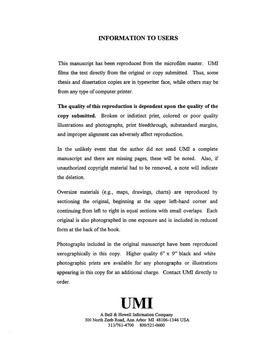| dc.contributor.advisor | O'Hair, Dan, | en_US |
| dc.contributor.author | Wallace, J. D. | en_US |
| dc.date.accessioned | 2013-08-16T12:30:34Z | |
| dc.date.available | 2013-08-16T12:30:34Z | |
| dc.date.issued | 1999 | en_US |
| dc.identifier.uri | https://hdl.handle.net/11244/5829 | |
| dc.description.abstract | This dissertation asks "what is meant by computer-mediated communication?" CMC was defined as it exists in the scholarly communication concerning business, education, psychology, sociology, and social sciences. This exploratory longitudinal analysis: examined the dynamic of computer-mediated communication in general, identified where academic scrutiny was being focused, and gives a general sense of the kinds of issues that were dominant during the time of examination. | en_US |
| dc.description.abstract | There were disparate foci between disciplines of differing perspectives. Multi-disciplinary with some interdisciplinary linkages would be a good description of CMC. Where there was interdisciplinary overlap, the communication discipline appears to be the boundary spanner in the majority of cases. This role did not extend to the business index analyzed. | en_US |
| dc.description.abstract | What was found was an area of scholarly communication, heavily popularized in education-related journals. Psychology and other social science affiliated disciplines contributed in a less prolific fashion. | en_US |
| dc.description.abstract | Specifically, this study employed bibliometric analytical techniques to establish CMC's artifacts, producers, and concepts within that domain. These were defined as journals, authors of those journals, and conceptual keywords. Artifacts and producers were identified based on their prevalence in the field and academic orientation. A more fine-grained analysis was applied to concepts. They were examined in terms of their prevalence, academic orientation and also their relationship to each other. | en_US |
| dc.description.abstract | This study was significant for three reasons. First, it documented CMC's historical emergence. Second, it identified descriptive boundaries concerning CMC's authors, journals, and areas of inquiry that were prevalent. Third, it examines the communication discipline's role in the literature as defined. Additionally, it provides guidance concerning CMC's future research. | en_US |
| dc.description.abstract | The distribution of first authors was overwhelming populated by one-time authorship. This significantly differed from theoretically defined literatures associated with a field of study. Moreover, CMC's articles tended to be localized in a relatively few journals. Clusters of conceptual topics tended to be database affiliated. Those with the most wide ranging support among all databases tended to come from topics traditionally associated with the communication discipline. Also "telecommunications", "information network" and "Internet" affiliated topics were widely indicated from a number of the databases. | en_US |
| dc.format.extent | xiv, 209 leaves : | en_US |
| dc.subject | Information Science. | en_US |
| dc.subject | Telecommunication. | en_US |
| dc.subject | Telematics. | en_US |
| dc.subject | Speech Communication. | en_US |
| dc.subject | Education, Language and Literature. | en_US |
| dc.title | An examination of computer-mediated communication's scholarly communication. | en_US |
| dc.type | Thesis | en_US |
| dc.thesis.degree | Ph.D. | en_US |
| dc.thesis.degreeDiscipline | Department of Communication | en_US |
| dc.note | Source: Dissertation Abstracts International, Volume: 60-05, Section: A, page: 1397. | en_US |
| dc.note | Adviser: Dan O'Hair. | en_US |
| ou.identifier | (UMI)AAI9930846 | en_US |
| ou.group | College of Arts and Sciences::Department of Communication | |
